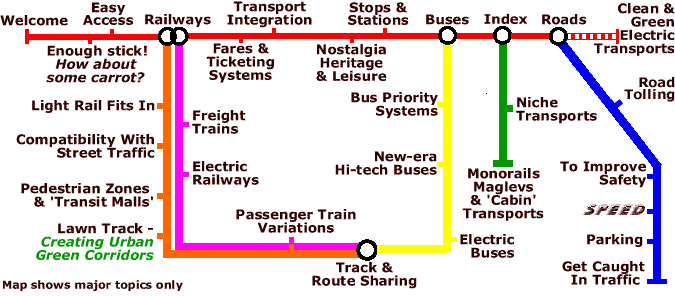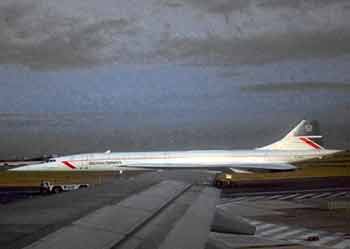 |
Welcome to this website.
These pages only look at surface transports as air travel is not (usually) used within the context of urban / suburban transit systems.
The late lamented Concorde as seen one evening from an
aircraft window at Heathrow Airport. Its demise on 24th October 2003 was inspired by accountants; this being "just typical" for a nation where the price of everything is known - but the value of nothing. One traveller on the last
flight described alighting from the plane as being "one small step for him - and one giant leap backwards for humankind". This photo was taken before the present-era paranoid restrictions on using cameras, camcorders etc; during take off
and landing.
Back to Welcome page.  |
|
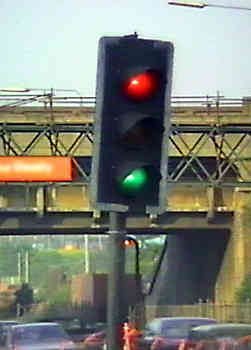 |
Everyone agrees that increasing public transport usage will help to reduce the congestion on our roads.
However because the public are not voluntarily giving up their cars (in favour of motorbuses) the politicians want to introduce
new forms of revenue generation (ie: back-door taxation) as sticks with which to try and force motorists out of their cars. What they have simply failed to do is offer the appropriate carrots as enticements.
Help! What do I do now
- stop or go??
Enough Stick, How About Some Carrot? |
|
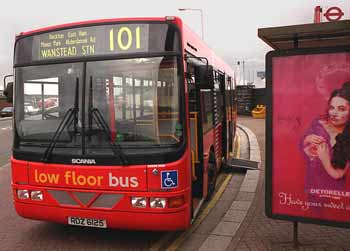 |
Many people think that easy access issues only relate to wheelchair users but in fact the whole community benefits, including parents with children in pushchairs, shoppers struggling with heavy bags and athletic fit sports fanatics
with a leg in plaster because it was broken in a skiing accident...
A low floor easy access bus with its wheelchair ramp extended.
Easy Access Transport |
|
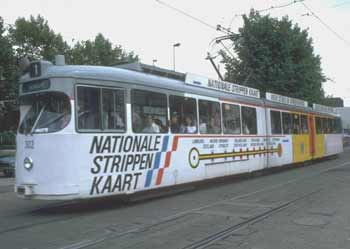 |
In many ways the ticketing system can hold the key to success in public transport. These pages explore the issues.
A Dutch tram advertising the "Strippenkaart" which was an easy to use pre-paid paper-based multi-ride ticket that could be
bought and used almost everywhere in Holland [for local / urban travel only] without leaving a big-brother surveillance style paper trail.
Fares & Ticketing Systems. |
|
 |
Buses, trains, trams (etc.,) may work well in themselves, but to be fully effective they need to operate together as part of an integrated transport system.
Grudging co-ordination is NOT enough!
Tram meets trolleybus for easy interchange in Zürich, Switzerland which with the public transports attracting over 50% of all journeys within the urban area has the most successful urban transport system in the
western world.
Transport Integration. |
|
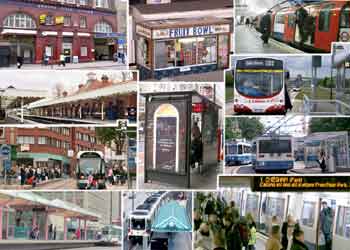 |
As part of the overall transport infrastructure the Stops and Stations are the systems "front door" and as such need to convey a smart, enticing image that will make them pleasant places to visit - otherwise potential passengers will be
deterred from using the transport before even before they see a vehicle.
Equally important however is that the transport comes at the expected times as passengers do not (usually) want to take up residence!!!
A montage of images showing bus + tram + railway stops, stations and shelters plus station platform food sales outlet.
Follow the link for full picture information.
Halts, Stops & Stations. |
|
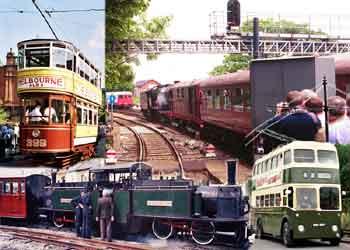 |
Nostalgia is very popular in our society. People are always looking back as if trying to recall some sort of golden era when life was believed to have been better - even though for the vast majority of us this was not so.
The only possible exception being with food as in "ye olde days" it was not adulterated with harmful chemicals as is the situation nowadays.
Sometimes Nostalgia overlaps into Heritage, as we look back to (for
instance) Roman times to see how people lived and how that era contributed towards creating the society in which we live today.
Leisure is about enjoyment, rest, relaxation, recuperation and hobbies and usually the transport
is there to take us through beautiful scenery, an exhibition, zoo, historic home, garden festival...
Follow the link for full picture information.
Nostalgia, Heritage & Leisure. |
|
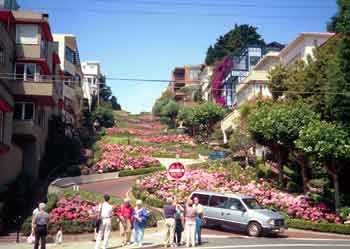 |
Full site index, listing every page in a plain-text format that all web browsers should be able to access.
Lombard Street in San Francisco is on a steep incline and to make life easier for horse-drawn transport it
was built in this zig-zag fashion. The unused space has been converted into gardens and planted to enhance the visual environment. Many people would simply love to live where they could travel along streets decorated with
flowers like this... perchance to dream!!!...
Index. |
|
 |
Electric transports have the potential to be the least environmentally damaging form of traction. Although this depends on how the power is sourced, even the dirtiest emissions are easier to reduce at a few power stations compared to
many hundreds of moving vehicles. Power stations can also use renewable energy - helping us to truly fulfil our commitments to the 1992 Rio Conference where our Prime Minister promoted the importance of sustainable development so that
this generation does not cheat on the next generation.. NB: Although the link works there is barely anything on the page - mirroring the situation in most of our towns & cities.
Red tram and trolleybus in an historic
city centre - so this must be London then??! Sadly not - these vehicles are in the Swiss capital city of Bern.
Electric Transports. |
|
 |
As part of a nations transport system the railways are the backbone.
Ranging from luxury high-speed InterCity expresses to street compatible trams and streetcars the railways offer the most efficient and environmentally beneficial
form of transport between and within urban areas. They are also a popular way to travel - experience has shown that rail is the most successful modal choice for enticing people to use public transport.
A Virgin Pendolino
InterCity express train and a London UndergrounD Bakerloo line tube train pass in North London.
Railways (General). |
| ------------------------------- ------------------------------- ------------------------------- |
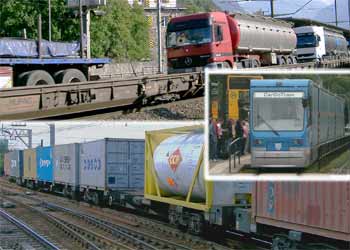 |
Most of the references to railways on these pages refer to passenger services, however we must not forget the rôle of the freight train. Often overlooked by transport strategy planners, railfreight represents the most energy efficient
and safest way to move large quantities of goods by land. Train drivers are highly-skilled people who must pass tough examinations covering all aspects both of the trains under their stewardship AND the tracks over which they operate (ie: speed limits,
location of signals, etc). Encouraging roadfreight to switch to the railways would be an excellent way to reduce congestion and "wear & tear" on our roads - as well as air pollution in the neighbourhoods through which they pass.
This link
leads directly to the "Freight Trains" section on the main railways page.
above In Europe even complete lorries go by train
below Many lorries worth of containers make up just one clean non-polluting electrically hauled British
freight train.
inset Freight service on an urban tramway
Freight Trains. |
| ------------------------------- ------------------------------- ------------------------------- |
 |
Of all the modes of transport electric railways have proven to be the most successful in providing the alternative choice which entices people to leave their cars at home.
Electrification provides the most efficient way of transmitting
power, especially on the busiest and most heavily trafficked routes where any additional capacity (either through longer trains or more frequent services) will require proportionally less additional energy when it comes from a common source rather than
on each train. Electric locomotives can deliver as much as 2½ times the tractive power output of an equivalent diesel.
Electric traction is for all types of train - passenger and freight.
Electric Trains. |
| ------------------------------- ------------------------------- ------------------------------- |
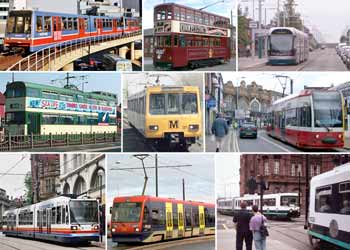 |
The first of several pages which look at light rail with a special emphasis on showing how it dovetails into the urban environment.
A selection of images from present-day British tram and light rail systems.
Follow the link for full picture information.
Light rail fits in. |
| ------------------------------- ------------------------------- ------------------------------- |
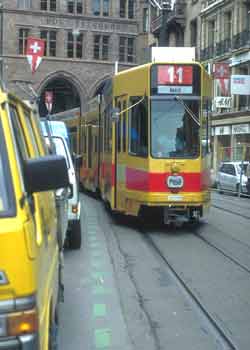 |
Specific examples of how tram stops fit in the street scene plus that trams and parked vehicles can coexist!
Basle, Switzerland: Green lines painted on the road surface can delineate the safe area in which vehicles can park without disrupting
light rail services.
Compatibility with street traffic. |
| ------------------------------- ------------------------------- ------------------------------- |
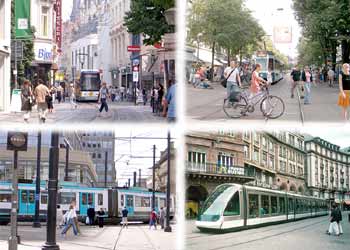 |
In many towns and cities it is usual for all but essential traffic to be barred from the central business and shopping areas. The ability to safely walk about, unhindered by noise and fumes seems to be what people want.
Pollution free trams calmly gliding through city-centre pedestrian zones in [top left clockwise] Gent, Belgium; Zürich, Switzerland; Strasbourg, France; and Manchester, England.
Pedestrian Zones and 'Transit Malls'. |
| ------------------------------- ------------------------------- ------------------------------- |
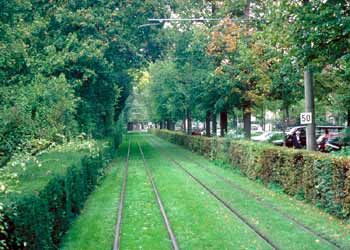 |
Lawn track is an attractive feature which brings more "greenery" into town.
With the trackage virtually invisible the effect can be almost as if the tram is flying over the grass!
The green way to travel - lawn trackage on route 8 in
Basle Switzerland.
Lawn Track - Creating urban green corridors. |
| ------------------------------- ------------------------------- ------------------------------- |
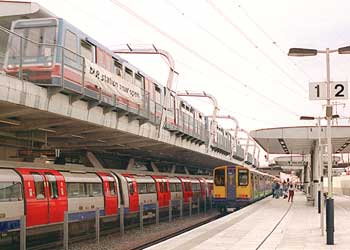 |
Different kinds of passenger train as defined by the type of service they provide.
Light rail, underground [subway / metro] and suburban heavy rail trains meet at Canning Town
Station in east London.
Passenger train variations. |
|
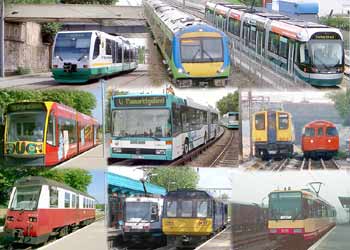 |
This page looks at track sharing which is where different types of guided transport operate over the same physical infrastructure and route sharing which
is where services will generally operate side-by-side using their own physical infrastructures.
Follow the link for full picture information.
Track & Route Sharing. |
|
Buses offer the cheapest, fastest and most flexible solution to traffic congestion.
However in many areas could-be passengers pro-actively choose to travel
by other means instead.
There are several Buses pages which explore various solutions to making bus travel popular again. |
| ------------------------------- ------------------------------- ------------------------------- |
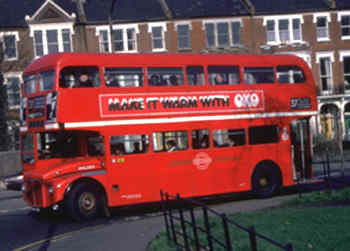 |
In the high-tech information age people do not want to be left hanging around at bus stops in the hopeful anticipation that some time in the near future a bus might
actually arrive.
This page looks at real-time information plus other bus-related subjects...
Despite being 30+ years old Londons Routemaster
bus is more popular than modern buses with doors because it does not spend ages at bus stops while passengers queue to pay on entry and the open rear platform lets
passengers board & alight when caught at traffic signals or in heavy traffic.
Buses. |
| ------------------------------- ------------------------------- ------------------------------- |
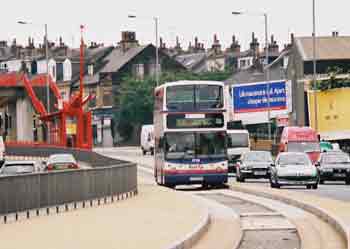 |
Nobody likes sitting in traffic and it is well known that given a choice most would-be bus users would much rather endure traffic congestion whilst sitting in their cars
listening to their stereos.
This page looks several types of bus priority and Bus Rapid Transit solutions suitable for both roads which are shared with other traffic and
dedicated private rights of way
Avoiding traffic congestion on Bradford's kerb guided busway.
Bus Priority Systems. |
| ------------------------------- ------------------------------- ------------------------------- |
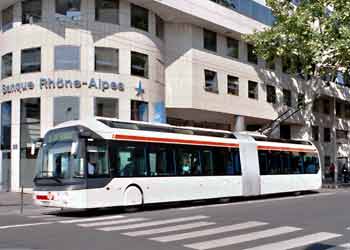 |
Light rail has proven to be exceptionally successful in enticing motorists out of their cars but even in large cities there will always be transport corridors where some
improvement over traditional buses is required but the traffic flow does not justify investing in rail transport.
This page look at the new breed of hi-tech buses currently
coming off manufacturers production lines.
One of the curvaceous space-age Cristalis hi-tech trolleybuses in Lyon, France.
New-era Hi-tech Buses. |
| ------------------------------- ------------------------------- ------------------------------- |
 |
In an era when environmental concerns are paramount these quiet, clean, popular, environmentally friendly buses are the only true bus solution to air pollution.
Zero emission electric operation means that they do not give city dwellers lungfuls of noxious exhaust fumes whilst studies have found that even when the electricity comes from
fossil fuel burning power stations there is still less pollution (in the wider environment) compared to using fossil fuel buses.
In May 2004 the Austrian city of Salzburg
hosted an international trolleybus conference under the slogan Pro-Trolley Bus is Pro-Environment. This promotional picture shows a new yellow & purple Athens (Greece)
trolleybus on demonstration next to one of their own trolleybuses. With 400 trolleybuses Athens has the largest fleet in Western Europe. Image sourced from the conference website
www.salzburger-verkehrstage.org/vg-1.html (external link opens in new window).
Electric Buses. |
|
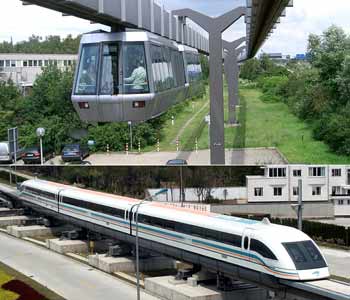 |
Monorails are often thought of as futuristic "space age" transports, yet outside of Japan seem to have been largely ignored as a viable transport option.
Maglevs are magnetic levitation trains which literally
"float" on a cushion of air.
"Cabin" transports are lower capacity transports for locations where service frequency is of the utmost importance. As with monorails and maglevs they too should be playing a greater
rôle in solving our urban transport problems.
A hanging monorail train on The Düsseldorf airport "Sky-Train" and the 430+km/h Transrapid Magnetic Levitation train which takes less than eight
minutes to travel the 30km between Pudong International Airport and Shanghai, China.
Monorail, Maglevs & Cabin Transports. |
|
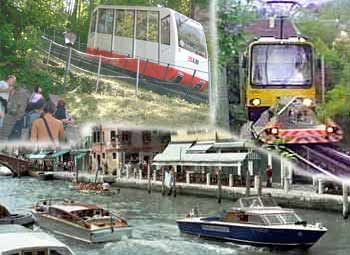 |
There will always be locations where different "specialist" transports will provide the optimum solution, even if only as feeders plugging the gaps that the mainstream transports leave unserved.
Included
on these two pages are transports for hilly cities, rack & pinion / cog wheel railways, funicular railways, suspended railway, hanging gondolas, water transports, moving walkways, lifts & escalators plus more...
Picture - Top: funicular left and rack & pinion right light railways
in Salzburg, Austria & Stuttgart, Germany. Below - a typical "water street" scene in Venice, Italy.
Niche Transports.
Cable Transports. |
|
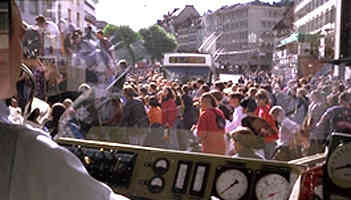 |
Oh No! Not another Stop The City demonstration by the anti-everything Luddites...
High jinx caught on camera! A group of Swiss youngsters in St Gallen delay light rail & trolleybus
services while they dance on and around a slowly moving flat bed van carrying a stereo system playing at full blast!
Roads Page |
| ------------------------------- ------------------------------- ------------------------------- |
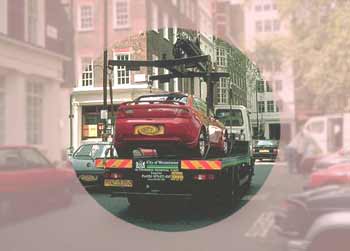 |
It would be wonderful if we could always park right outside our destinations, without either parking charges or traffic wardens to worry us! Of course, we would all want to be able to do this, and all the time!
Sadly, the reality is that in urban areas it is just not possible - there are too many vehicles and they would all be chasing the same few parking spaces.
Anyone who thinks that they should allways be able to park right
outside their destination must be looking at life through rose-tinted glasses; if they looked through this lens they would see a far less palatable reality!
Parking Page. |
| ------------------------------- ------------------------------- ------------------------------- |
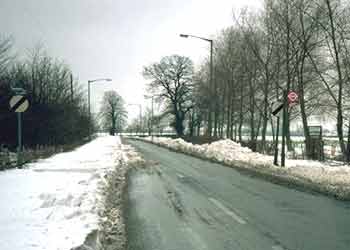 |
In the name of safety petty officials see motorists as easy prey for every kind of money grabbing and anti-car behaviour imaginable. Targeting vehicles for travelling at speed is a specially favoured endeavour of theirs, whilst
non-revenue raising methods of making motoring safer are too rarely considered. In 2003 the Italians, Danes and Norwegians raised motorway speed limits - because they know that speed, as such, does NOT kill whilst tiredness through
spending too long driving without a break also causes accidents.
Road users demand 100% safety, but they also expect to travel quickly and arrive ASAP. In conditions such as this only a fool would even consider trying to
get anywhere near the 60mph limit [40mph for lorries] beyond the road signs.
Speed Page. |
| ------------------------------- ------------------------------- ------------------------------- |
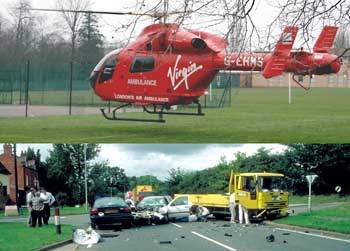 |
Britain has some of the safest roads "anywhere" in our global family of nations. Despite ever increasing traffic levels our accident rate has being falling for years. Currently about 3,500 people die each year on our roads, and whilst
that is still too high as a comparison if we took present day traffic levels and the accident rate of 1965 the toll would be a horrific 15,000 pa.
This link leads to a "road safety" section of the main roads page and looks
at a few simple ideas which if implemented would reduce the death toll caused by accidents. Some of these may require legislation.
In some areas air ambulances are used as they can transport people to hospital (whether the emergency situation was
originally traffic-related or from other causes) far more rapidly than road-based transports.
Road Safety. |
| ------------------------------- ------------------------------- ------------------------------- |
 |
At one time it was common for road users to pass turnpikes where they would have to pay a toll for using a section of roadway, with the monies raised being spent on highway maintenance. However over time funding became available
from other sources and the turnpikes were (mostly) abolished. Now the principle is being revisited (in Britain) as part of a global trend towards reducing traffic congestion.
Its all about money! £ $ ¢ €
¥ ¤
Tollgate on College Road, Dulwich, London SE21 - a slice of medieval life still very much "alive and kicking" in south London
Road User Tolling & Congestion Charging. |
| ------------------------------- ------------------------------- ------------------------------- |
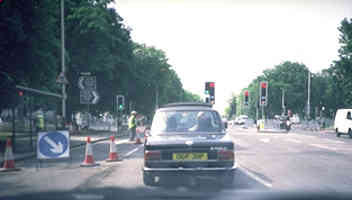 |
To say that all traffic congestion is caused by too much (or illegally parked) traffic is not the whole story. These roadworks were in connection with introducing Londons draconian anti-illegal parking red routes & cost
me over 20 minutes in lost (ie: stolen) time.
Several bus routes use this road and they too were unwilling victims of these works.
Severe traffic delays caused by road works halving the road width at traffic signals.
Get caught in traffic. |
English Common law requires that victims of crime must always try to mitigate (ie: minimize) their losses, so the ideal solution would be to drive faster over the rest of the journey to try and make up for
the stolen time ... somehow I suspect that whilst most motorists would agree with this idea the cult of sloth (slowness) loving, Luddite pro-horse and cart anti-car brigade who advocate 20 mph / 30km/h as being plenty fast enough
would be far less enthusiastic with this solution. |
|
